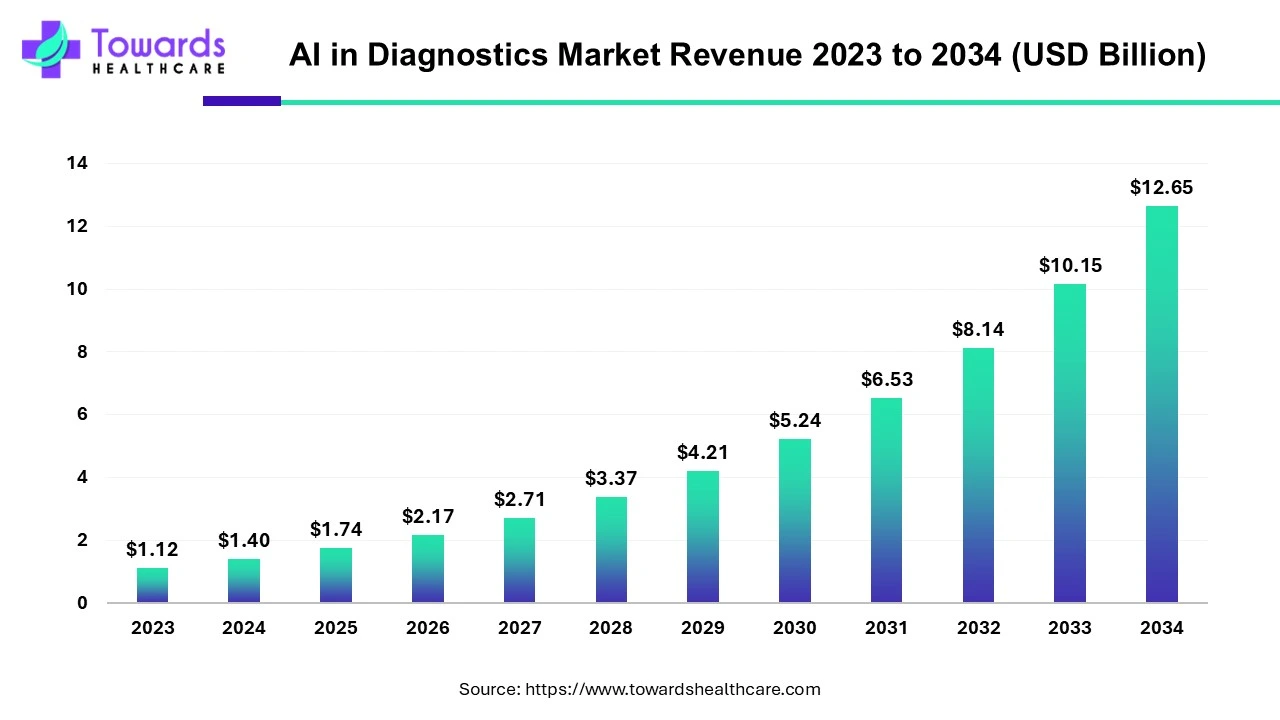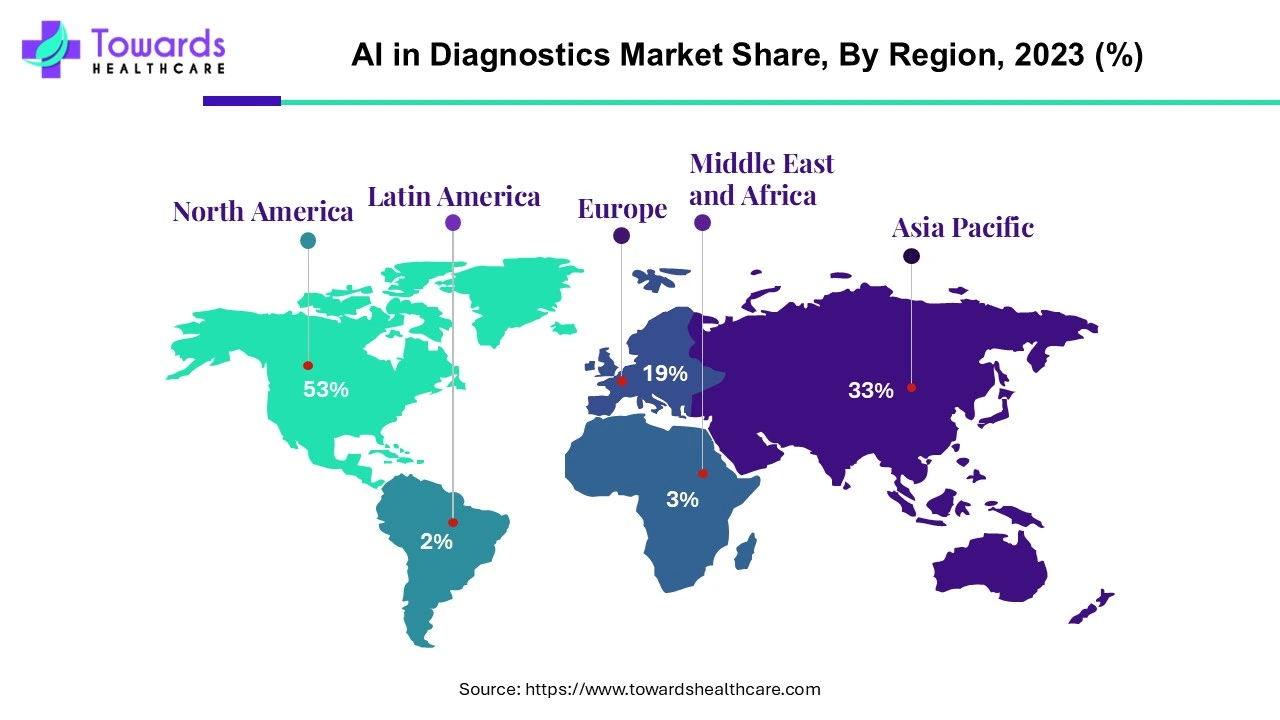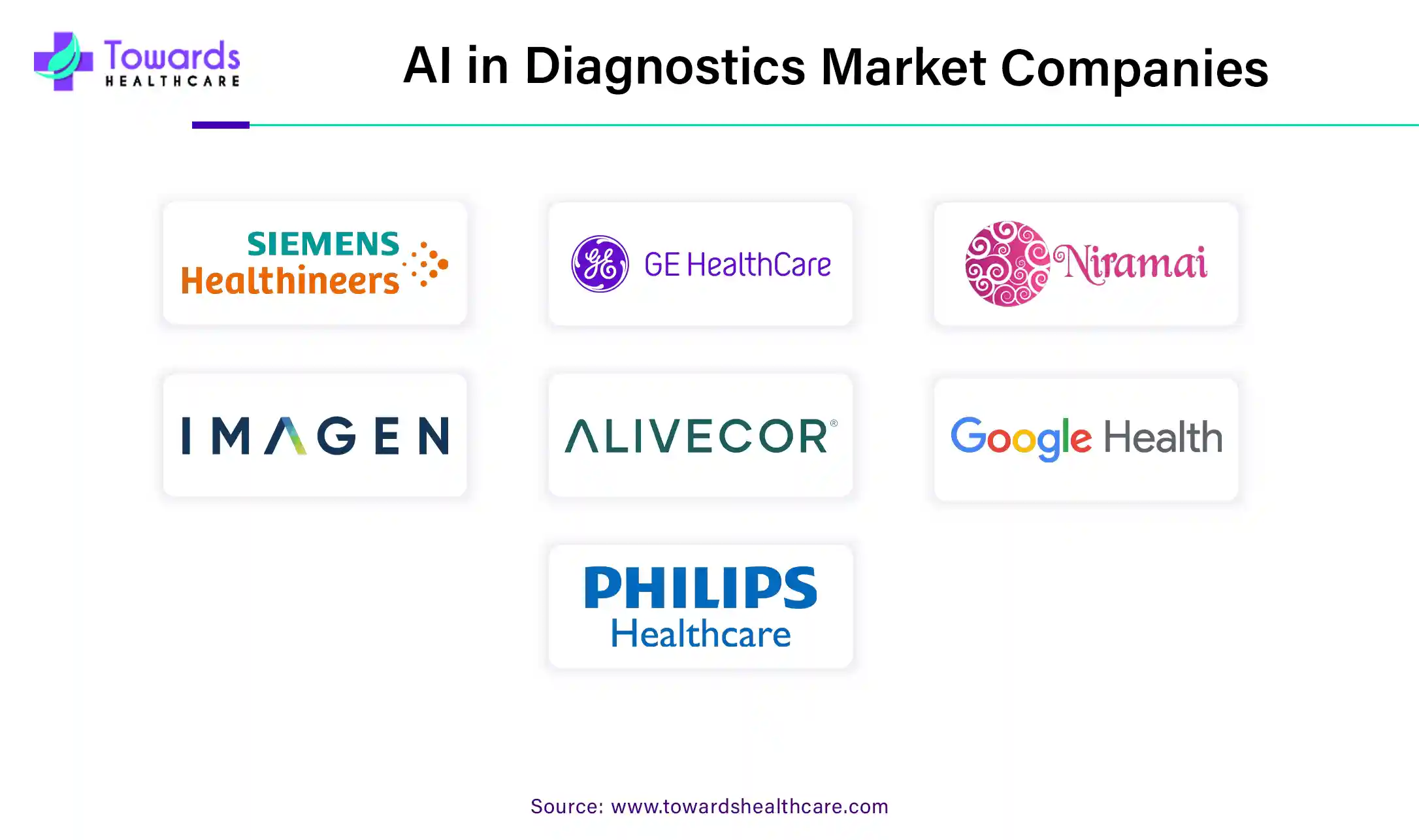April 2025

The global AI in diagnostics market was estimated at US$ 1.12 billion in 2023 and is projected to grow to US$ 12.65 billion by 2034, rising at a compound annual growth rate (CAGR) of 24.64% from 2024 to 2034. The demand for AI in diagnostic testing has increased significantly due to the various benefits AI provides. One of the major benefits is reduced human error, which improves overall diagnostic results that can be used by professionals to develop appropriate treatment options.

Artificial intelligence (AI) has become a significant part of healthcare and is being used in almost all sectors, including diagnostics. The integration of AI has increased the growth and development of the healthcare industry. In diagnostic testing, AI is used to analyze medical images (CT scans, X-rays, ultrasounds, MRIs, and DXAs), large patient data, vital signs (pulse rate, body temperature, blood pressure, and respiration rate), medical history, and laboratory test results. AI provides several advantages in diagnostics, such as accuracy, efficiency, reduced human errors, and cost savings. Healthcare professionals can make more informed decisions and develop personalized treatment options. The AI in the diagnostics market is growing due to reduced healthcare costs, reduced healthcare burden on professionals, and enhanced patient satisfaction.
For instance,
| Recipient Name | Dispatching Party | Product Code Explanation | Total Quantity | Total Weight |
| Air New Zealand C O LSG Skychefs | Air New Zealand Limited Inflight | Medical Devices | 954456 | 13155 |
| Brother International Corp | Brother Industries Vietnam Limited | Automatic Data Processing Machines | 532121 | 3476290 |
| Edwards Lifesciences Technology SAR KM | C C T Critical Care Technologies S | Medical Devices for Monitoring | 428603 | 639810 |
| Four Paws Products Limited | Jiangsu Zhongheng Pets Articles Joi | Pet Supplies | 334534 | 2386965 |
| Leviton Manufacturing Co Inc | Leviton Electronic Dongguan Co Limited | Electrical Machinery | 264592 | 421151 |
| Ito EN North America Inc | Taisun Enterprise Co Limited | Beverages | 178648 | 1078576 |
| Dole Fresh Fruit Company | Standard Fruit Company | Food Processing Equipment | 162315 | 3111054 |
| Jtekt Automotive North Americas Inc | Shin Ei High Tech Co Limited | Automotive Parts | 143878 | 218526 |
In healthcare diagnostics, automation is needed to perform repetitive tasks, reduce turnaround times, and reduce errors that can occur due to human interaction. Automation is also valuable in reducing the workload of healthcare professionals, which leads to work satisfaction and better patient care. Using AI in automation has made diagnostics even more efficient. ‘Smart Labs’ integrated with AI are capable of functioning 24/7 with minimal human supervision, thereby providing real-time results. In the future, AI-based robot technologies will become capable of performing intelligent operations. There is also a shortage of healthcare professionals, which increases work pressure on professionals working in hospitals, laboratories, and other healthcare settings. AI-enabled automation can also help overcome this issue. Automation can be highly valuable during disease outbreaks or pandemics. It can speed up data analysis, medical imaging, testing, and other tasks.
For instance,
There is a growing demand for professionals in diagnostics centers and laboratories due to the rising population, infectious diseases, and chronic conditions. Apart from this, a lot of professionals lack the skills to operate AI-integrated hardware and software. Due to this, the healthcare sector lacks medical experts for diagnosis and testing, causing restraint to the AI in diagnostics market. It is essential to fulfill the demand and train diagnostic professionals to handle machines and software with advanced technologies. Medical universities, hospitals, and governments can take the initiative, develop courses, and provide timely training for enhancing skills and knowledge.
Preventive care has become a really necessary step for improving health. Growing infectious diseases and chronic conditions have increased the burden on healthcare resources and professionals. It is estimated that the healthcare cost will rise up to US$ 176 billion without effective interventions, which is going to increase the demand for preventive care in the future. With the help of AI in diagnostics, this can be reduced as AI can play a significant role in preventive care. Preventive care involves analyzing medical records, medical history, lifestyle, genetics, and other aspects to identify future health risks. However, it is a very time-consuming and tedious process. Healthcare workers are prone to errors when analyzing such a large amount of data, which can lead to misinterpretation. The use of AI can mitigate all these challenges and help in analyzing health risks with data analytics in less time with more accuracy and efficiency.
For instance,
By component, the software segment held the largest share of the AI in diagnostics market in 2023 and is expected to showcase the fastest CAGR during the forecast period. Leveraging AI in diagnostic software has become a common practice. Medical diagnostic software is a digital platform used in precision and high-speed diagnosis. Advanced software comes with AI automation that is able to assess large amounts of data. Customized software has also been developed to improve diagnosis and decision-making. Recently, there has been a growth in the number of organizations that specifically develop diagnostics and other healthcare-related software.
For instance,
By diagnosis, the neurology segment accounted for the dominant share of the AI in diagnostics market in 2023. Artificial intelligence (AI) systems are capable of analyzing MRI and CT images to find minute anomalies that might point to illnesses like brain tumors, strokes, or neurodegenerative disorders. These algorithms can frequently spot subtleties and patterns that human radiologists would overlook, which expedites the diagnosis and start of therapy. AI models are able to forecast the course of diseases such as multiple sclerosis, Parkinson's disease, and Alzheimer's disease. AI is able to recognize early indicators of the course of a disease and tailor treatment regimens in response by evaluating patient longitudinal data.
For instance,
By diagnosis, the radiology segment is expected to grow at the fastest rate in the AI in diagnostics market during the predicted period. The field of radiology has a lot of promise for artificial intelligence, which is already beginning to transform healthcare in many ways. These include simplifying data interpretation through advanced AI algorithms and enhancing the diagnostic process, as well as bridging the gap between the number of radiologists and the demands of ever-increasing, extremely complex data. AI is a useful technology that has enormous promise for the healthcare sector when paired with the human skills of radiologists and physicians.
For instance,

By region, North America dominated the AI in diagnostics market share by 53% in 2023. North America excels in various aspects of healthcare, including pharmaceuticals, biotechnology, healthcare systems, research and development, and innovation. North America is also leading in technological advancements, giving healthcare a boost. AI and machine learning are an integral part of technological advancements. North America Also faces challenges associated with a growing number of cancer patients, chronic conditions, and infectious diseases. These health issues need proper diagnosis and analysis, which drives the market’s growth in this region.
The U.S. dominated the AI diagnostics market in North America due to growing technological advancements and investments in the healthcare industry. The United States has a number of machine learning (ML) technologies that can help with diagnosis. Benefits from this include improved access to treatment, especially for underprivileged communities, earlier illness identification, and more consistent analysis of medical data. The majority of the ML-based technologies that the GAO (Government Accountability Office) identified for five specific diseases are dependent on data from imaging tests like magnetic resonance imaging (MRI) or X-rays. The diseases include certain cancers, diabetic retinopathy, Alzheimer's disease, heart disease, and COVID-19. In order to mitigate these issues or improve the advantages of machine learning diagnostic technology, GAO created three policy recommendations.
By region, Asia Pacific is expected to grow at the fastest rate during the forecast period. AI technology is being used more often in the Asia Pacific area to diagnose and identify ailments as a result of the growing number of elderly people living there and the rising incidence of diseases like cancer and stroke. The rise of the AI in diagnostics market in the area is also largely driven by rising investment in AI healthcare businesses. Additionally, increased financial support for the use of AI technology and the creation of AI tools in healthcare from the public and commercial sectors in emerging nations.
Both governmental and private initiatives are contributing to the growth of AI-based diagnostics solutions. Regional industry growth is boosted by investment, visibility, and startups. Regional AI in diagnostics market expansion is also impacted by startup incubators and private funding. The Asia-Pacific market is also anticipated to be driven by the expanding patient pool, pandemic, cloud computing, and government AI initiatives. AI is now being employed by biopharmaceutical businesses to modernize drug research and diagnostics.
For instance,

| Company Name | GE Healthcare |
| Headquarters | Illinois, U.S., North America |
| Recent Development | In July 2024, for a total estimated value of $51 million, GE HealthCare stated that it had entered into an agreement to buy the clinical AI software business of Intelligent Ultrasound Group PLC (Intelligent Ultrasound). Leading provider of integrated AI-driven image analysis solutions, Intelligent Ultrasound, aims to improve the intelligence and efficiency of ultrasound. |
| Company Name | Paige |
| Headquarters | Los Angeles, U.S., North America |
| Recent Development | In August 2024, the AI startup Paige unveiled a brand-new offering. The New York City-based business revealed a biomarker module driven by artificial intelligence (AI), which it claims is capable of identifying 1,228 molecular biomarkers from typical pathology slides and evaluating over 505 genes. Hematoxylin and eosin (H&E) are used in the new product, OmniScreen, to assess digital photos of stained cancer tissue slides. |
Prashant Warier, Co-Founder and CEO of Qure.ai believes that AI in healthcare is still in its infancy, but the potential is vast. He commented that AI brings consistency to the patient’s X-ray or other imaging data reports. He shared that the company will integrate multiple data points to create more holistic AI models. He envisioned that the shift would enable doctors to make more informed decisions by considering a patient’s full medical history with diagnostic imaging.
By Component
By Diagnosis
By Region
April 2025
April 2025
April 2025
April 2025